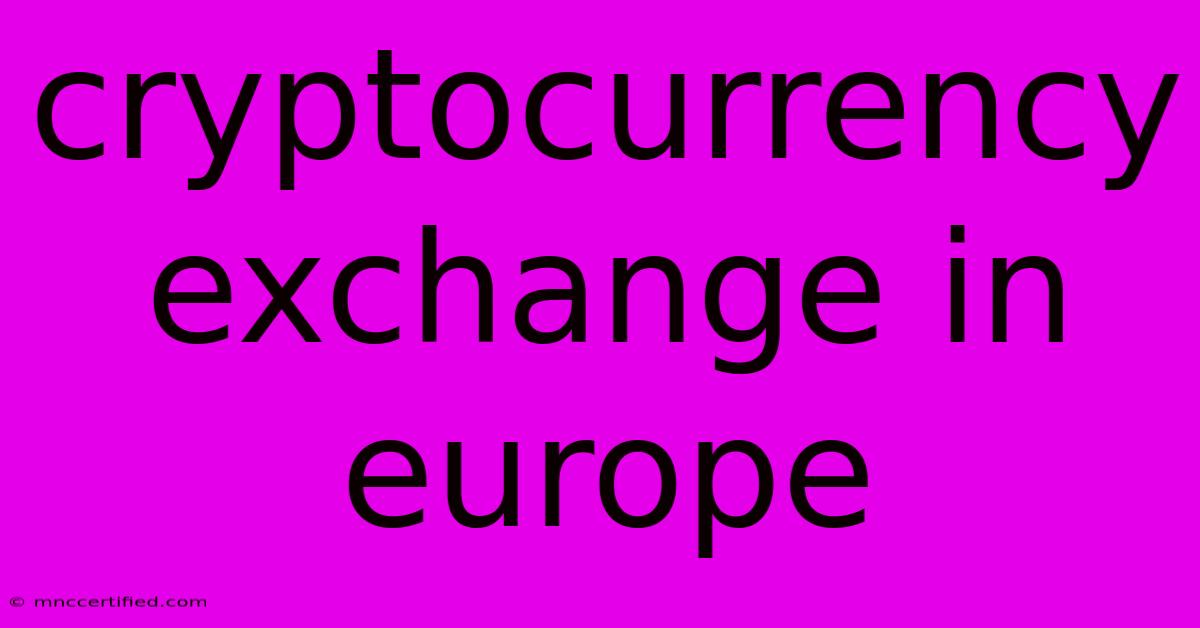Cryptocurrency Exchange In Europe

Table of Contents
Cryptocurrency Exchanges in Europe: A Comprehensive Guide
Europe's cryptocurrency market is booming, attracting both seasoned investors and newcomers. Navigating this landscape requires understanding the regulatory environment and choosing a suitable exchange. This guide provides a comprehensive overview of cryptocurrency exchanges in Europe, focusing on key factors to consider when selecting a platform.
Choosing the Right Cryptocurrency Exchange in Europe: Key Factors
Selecting the right exchange is crucial for a safe and efficient trading experience. Consider these factors:
1. Regulation and Security:
- Licensing and Compliance: Prioritize exchanges licensed and regulated within the European Economic Area (EEA). Regulations like the Markets in Crypto-Assets (MiCA) regulation are shaping the landscape, and choosing a compliant exchange minimizes risks. Look for exchanges that openly display their licenses and adherence to anti-money laundering (AML) and know-your-customer (KYC) regulations. Security features such as two-factor authentication (2FA), cold storage for assets, and robust cybersecurity measures are paramount. Read independent security audits if available.
2. Supported Cryptocurrencies and Trading Pairs:
- Variety: Consider the range of cryptocurrencies offered. Major exchanges generally support Bitcoin (BTC), Ethereum (ETH), and other prominent altcoins. However, if you're interested in niche or lesser-known cryptocurrencies, ensure your chosen exchange lists them.
- Trading Pairs: Pay attention to the available trading pairs (e.g., BTC/EUR, ETH/USD). Having diverse trading pairs offers greater flexibility.
3. Fees and Charges:
- Trading Fees: Exchanges charge fees on trades, typically a percentage of the transaction value. Compare fees across platforms, as they can vary significantly. Some exchanges offer tiered fee structures based on trading volume.
- Deposit and Withdrawal Fees: Consider fees associated with depositing and withdrawing funds. These fees can vary depending on the payment method and cryptocurrency.
4. User Experience and Features:
- Ease of Use: The platform should be intuitive and easy to navigate, even for beginners. Look for a user-friendly interface with clear instructions and helpful resources.
- Mobile App: A well-designed mobile app enhances accessibility and allows for trading on the go.
- Customer Support: Reliable customer support is essential. Check the availability of various support channels (e.g., email, phone, live chat) and their responsiveness.
5. Liquidity and Trading Volume:
- Order Book Depth: A deep order book indicates high liquidity, meaning you can easily buy or sell large amounts of cryptocurrency without significantly affecting the price.
- Trading Volume: High trading volume suggests a more active and reliable market.
Top Cryptocurrency Exchanges in Europe (Note: This is not an exhaustive list, and rankings can change frequently. Always conduct thorough research before selecting an exchange.):
While specific rankings fluctuate, several exchanges consistently appear near the top for European users. Remember to research each independently before using their services. Focus on the criteria above when making your selection.
Regulatory Landscape of Crypto in Europe: MiCA and Beyond
The Markets in Crypto-Assets (MiCA) regulation is a significant development for the European crypto market. It aims to create a comprehensive regulatory framework, addressing issues such as market abuse, consumer protection, and stablecoins. Understanding MiCA's implications is vital for anyone investing in or operating within the European cryptocurrency ecosystem. The implementation and impact of MiCA are ongoing and will continue to shape the future of crypto exchanges in Europe.
Security Best Practices for European Crypto Users
Regardless of the exchange you choose, practicing good security hygiene is crucial. This includes:
- Strong Passwords: Use unique, strong passwords for all your accounts.
- Two-Factor Authentication (2FA): Enable 2FA for an extra layer of security.
- Regular Security Audits: Stay informed about potential security breaches and update your security practices accordingly.
- Beware of Phishing Scams: Be cautious of suspicious emails or websites that request your login credentials.
Conclusion
Choosing a cryptocurrency exchange in Europe requires careful consideration of several factors. Prioritizing regulation, security, fees, user experience, and liquidity will help you select a platform that aligns with your needs and risk tolerance. Always conduct thorough due diligence before entrusting your funds to any exchange. Remember that the crypto market is volatile, and investment decisions should be made carefully. This information is for educational purposes only and should not be considered financial advice.

Thank you for visiting our website wich cover about Cryptocurrency Exchange In Europe. We hope the information provided has been useful to you. Feel free to contact us if you have any questions or need further assistance. See you next time and dont miss to bookmark.
Featured Posts
-
Goffs Impressive Lions Win Nfl Record
Nov 18, 2024
-
Raiders Vs Dolphins Odds Picks And How To Watch
Nov 18, 2024
-
England Vs Ireland Live Nations League Result
Nov 18, 2024
-
Kansas City Chiefs Vs Buffalo Bills
Nov 18, 2024
-
Nfl Week 11 Lions Dominate Jaguars
Nov 18, 2024